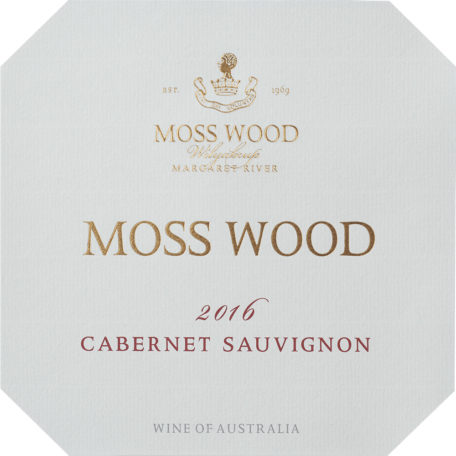Moss Wood 2016 Cabernet Sauvignon

| Wine Facts | |
|---|---|
| Blend | Cabernet Sauvignon 91% Petit Verdot 5% Cabernet Franc 4% |
| Median Harvest Date | Cabernet Sauvignon – 17/03/2016 Petit Verdot – 19/03/2016 Cabernet Franc – 12/03/2016 |
| Harvest Ripeness | Cabernet Sauvignon – 13.7°Be Petit Verdot – 13.5°Be Cabernet Franc – 13.2°Be |
| Yield | Cabernet Sauvignon – 4.34 t/ha Petit Verdot – 4.48 t/ha Cabernet Franc – 3.66 t/ha |
| Weather Data | Growing Season Ave Temperature – 20.0⁰C Number of hours accrued between 18° and 28⁰C – 1095 Number of hours above 33° – 72 |
| Days Elapsed between Flowering and Harvest | Cabernet Sauvignon – 122 days Petit Verdot - 123 days Cabernet Franc – 122 days |
| Bottled | 06/11/2018 |
| Released | 15/03/2019 |
| Alcohol | 14% |
Wine Facts
-
Blend
Cabernet Sauvignon 91%
Petit Verdot 5%
Cabernet Franc 4%
-
Median Harvest Date
Cabernet Sauvignon 17th March, 2016
Petit Verdot 19th March, 2016
Cabernet Franc 12th March, 2016
-
Harvest Ripeness
Cabernet Sauvignon 13.7°Be
Petit Verdot 13.5°Be
Cabernet Franc 13.2°Be
-
Yield
Cabernet Sauvignon 4.34 t/ha
Petit Verdot 4.48 t/ha
Cabernet Franc 3.66 t/ha
-
Weather Data
Growing season Ave Temperature - 20⁰C
Number of hours accrued between 18° and 28⁰C – 1095
Number of hours above 33⁰C – 72
-
Days Elapsed between Flowering and Harvest
Cabernet Sauvignon 122 days
Petit Verdot 123 days
Cabernet Franc 112 days
-
Bottled
6th November, 2018
-
Released
15th March, 2019
-
Alcohol
14.0 %
Moss Wood 2022 Cabernet Sauvignon – The Cellar Post
Beautiful definition and purity on the nose that shows fresh cassis, blackberries, and black plum, with cedar, pencil shavings, subtle vanilla and mocha nuances. Medium-full, superb freshness and concentration on the palate, dark fruit with a vibrant streak of purple, excellent oak spice, clove and tobacco, firm tannins and vibrant…
Vintage Notes
We couldn’t have been happier with the 2015/16 season. The spring weather was very respectable indeed. Our 2015 calendar year rainfall of 959mm, although 5% below average, was still within the more than adequate range for vine hydration in our mild climate. Flowering for the Cabernet varieties was good, with only 4 days when the temperature dropped below 8°C and only 6 wet days, so conditions were very much in our favour. By early January 2016 we were feeling very pleased with ourselves. We’re always optimistic but cautious. The consistent quality of vintages, especially with Cabernet Sauvignon, is testament to how benign Margaret River’s climate is.
There is no better way to understand this than by examining the temperature record for 2015/16. The vines enjoyed just the sort of temperatures that allow them to ripen steadily. In the end they received 1095 hours between 18°C and 28°C, their ideal range. There were 8 hot days, where the temperature reached 35°C, and the highest maximum was 39°C on 7th January and 7th February. Cabernet Sauvignon, in particular loves this warmth and we are happy if it receives 50 hours above 33°C and in 2016 it had 72. In summary, Cabernet Sauvignon ripened just about perfectly.
Just to ensure readers don’t think we’re becoming smug, we should add that perhaps Mother Nature took the view we were becoming complacent? After all, she’d given us some classic seasons in the last decade and especially the last two releases, the 2014 and 2015 vintages. On 18th January, she gave us the first of 4 days of rain that delivered 107mm. This produced a collective holding of breath in Margaret River while we waited to see the impact. As a matter of reassurance, unirrigated vineyards like Moss Wood and Ribbon Vale usually respond well to such events, especially if the timing is right. In this instance, things were in our favour because the fruit was still green and not soft enough to split and the vines took up the moisture without a problem. Similarly, the Cabernet varieties resist bunch rot reasonably well and combined with our fungicide program ensured the crop remained healthy.
We got several further rains, including a very handy top up of 20mm in mid-February which really did the vines good, ruling out any risk of moisture stress towards the end of ripening.
All three varieties, Cabernet Sauvignon, Cabernet Franc and Petit Verdot were all ripe roughly a week ahead of average and everything was going according to plan until the we started weighing the bins as they arrived at the winery. To our amusement and not to mention disappointment, yields were down around 40%. What did we say about smug? We have put our viticultural thinking caps on to try and understand this but our best explanation is after the excellent crops up to and including 2014, we suspect the vineyard nutrition has waned and we are working towards restoring this with mineral fertilisers and compost. It is important to understand that since the wine leaves the property, going to markets all around the world, never to return and taking with it numerous important nutrients from the soil, we need to replace these losses from outside sources. All the organic matter we produce but do not use, for example the bunch stalks and grape skins, is composted and returned to the soil. However, this is not sufficient to cover the deficit and hence the need to fertilise.
Regardless of the reduced quantity, we couldn’t have been more pleased with the sugar levels and flavour ripeness.
Production Notes
All the fruit was hand-picked and delivered to the winery where it was de-stemmed and placed into small, open fermenters, where each batch was seeded with multiple yeast strains. Fermentation was maintained at a maximum of 30°C and extraction of colour and tannin was by hand plunging, 3 times per day. It is a testament to the ripeness of the fruit that skin contact times were relatively short, with Cabernet Sauvignon on skins for 2 weeks, Cabernet Franc for 9 days and Petit Verdot for 12 days.
After pressing each batch underwent malolactic fermentation in stainless steel and was then racked to barrel through April 2016. All the barrels were 228 litre French oak barriques and 18% were new. On 22nd January 2018 the final blend was made up and returned to barrel, where it stayed until late October 2018, when it was racked to stainless steel in readiness for bottling.
The final blend is 91% Cabernet Sauvignon, 5% Petit Verdot and 4% Cabernet Franc.
We pride ourselves on ensuring Moss Wood Cabernet Sauvignon is ripened as well as the vintage allowed but each year, just to be on the safe side, we carry out fining trials to assess tannin balance and see if it can be improved. Once again with the 2016, we found none of the agents benefited the wine, so it remained unfined. It was then sterile filtered and bottled on 6th November 2018. The bottling included 350 individually numbered 1.5 litre magnums.
Tasting Notes
Colour and condition:
Deep brick red, in bright condition.
Nose:
Showing all the classic Moss Wood aromatic features with Cabernet Sauvignon’s blueberries and mulberries, Cabernet Franc notes of blackberries and violets and Petit Verdot giving sweet musk lollies and dark jubes. Since the wine had such long barrel age, these fruit notes are underpinned by tar, leather and cedar notes as well as a touch of charry oak. These all combine to give the ‘16 a notable intensity, making it one of the more complex Cabernet Sauvignons we’ve made for some time, sharing many similarities with the mighty 2005.
Palate:
Each of the varieties work their magic on the palate, combining to give generous blueberry, blackberry and red currant flavours. As we mentioned above, the season delivered near-perfect conditions for fruit ripeness and this is evident in the tannins which are classic Moss Wood. The requisite balance, smooth and supple velvet texture are present but the tiny yields have given greater concentration, meaning there is a density only seen in the very best years. Everything is rounded out by a subtle oak note, just a little reminder of its 2 years in French oak barriques.
Cellaring
The youthful intensity of the wine is such that it can be consumed as a youngster. The aroma intensity and palate concentration really lend themselves to enjoyable early drinking. Nevertheless, it will reward those with patience. We noted the similarity with the 2005 and that vintage is just beginning to show some maturity at 14 years of age. We are very confident the 2016 will develop in a similar way, reaching full maturity at around 25 years of age.

